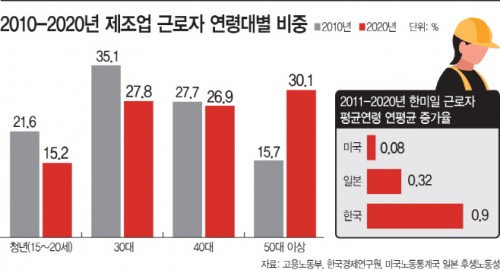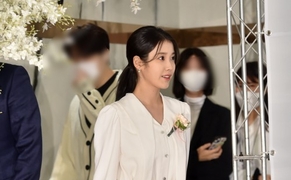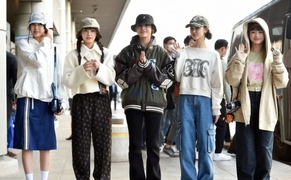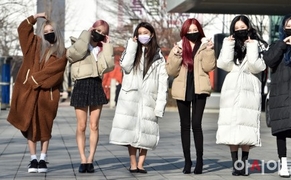 |
| Sources: South Korea’s Ministry of Employment and Labor (MOEL)/ Korea Economics Research Institute (KERI)/ U.S. Bureau of Labor Statistics/ Japanese Ministry of Health, Labor and Welfare |
AsiaToday reporter Park Ji-eun
Three out of ten manufacturing workers in South Korea are found to be in their 50s. They are people who have been employed in the mid-1990s and have held the same position for more than 20 years. South Korea’s ‘old factory’ is mainly caused by the country’s rapid population aging and the fact that young people in their 20s and 30s are avoiding to work in the manufacturing industry. As the country’s manufacturing workers have been aging much quicker than those in the United States and Japan, there are growing concerns that it may undercut the country’s growth potential drastically.
People aged 50 and older accounted for 30.1 percent of the country’s total manufacturing workers in 2020, up from 15.7 percent 10 years earlier, according to a report from the Korea Economic Research Institute (KERI) released on Monday. The figure increased 14.4 percentage points in a decade.
In contrast, the ratio of manufacturing workers in their 30s fell to 27.8 percent from 35.1 percent over the cited period, the sharpest drop among all age groups. The ratio of manufacturing employees aged 15-29 declined to 15.2 percent from 21.6 percent, with that of workers in their 40s decreasing to 26.9 percent from 27.7 percent. KERI said the near twofold increase in the number of senior manufacturing workers shows how serious the aging of the country’s manufacturing workforce is.
The country’s manufacturing industry is undergoing aging at a faster rate compared to other major manufacturing powerhouses, including the United States and Japan. The average age of South Korean manufacturing employees stood at 42.5 years old in 2020, up 3.3 years from 2011. On the other hand, Japan average rose by 1.2 years to 42.8 years old in 2020 from 41.6 years old in 2011, while the figure for the US went up 0.3 years to 44.4 years old from 44.1 years old. The increase in the average age of Korean workers was 11.3 times faster than that of the US, and 2.8 times that of Japan during the period between 2011 and 2020, the report said.
KERI attributed the fast aging of Korea’s manufacturing workforce mainly to rapid population aging coming from the country’s low birthrate and overprotection of regular workers due to stringent regulations. It said that it was more difficult for younger workers to enter the manufacturing industry as new investments and employment contracted. The number of manufacturing jobs increased by 597,000 from 2010 to 2015, but only by 71,000 from 2015 to 2020. Manufacturing employment has contracted significantly in the last five years.
“The aging of the manufacturing industry, which has played a pivotal role in the country’s economic growth, will lead to a decline in industrial and national competitiveness, and will intensify income polarization among generations and youth poverty,” said Choo Kwang-ho, head of KERI’s economic policy team, in the report.
#manufacturing #aging #South Korea #KERI
Copyright by Asiatoday
Most Read
-
1
-
2
-
3
-
4
-
5
-
6
-
7





















